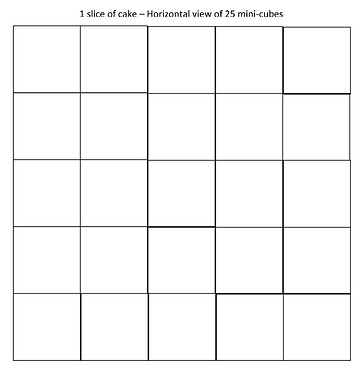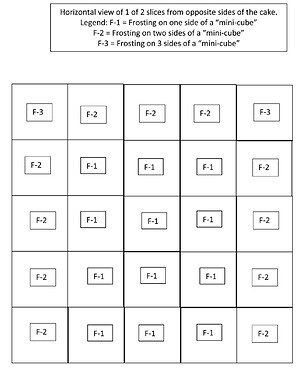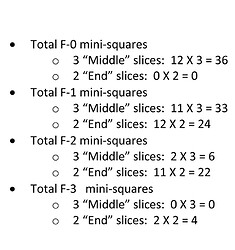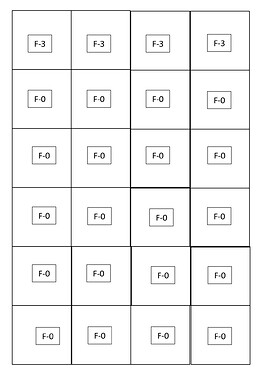I’m going to have to see that video “to believe it”. Without the video, I just hear static for a couple of moments, then a sizzle, and finally a popping noise in my head, accompanied by a burst of light. Then everything goes dark. ![]()
Perhaps easiest to visualize with north pole being one vertex, and two vertices along the equator.
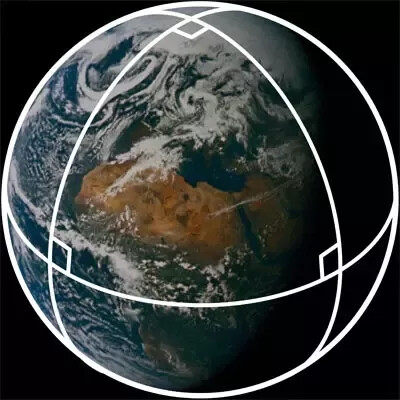
The concept itself is not difficult to visualize. If two people started at the equator and travelled directly north (90 degrees to the equator) then they would meet at the north pole. If they are the right distance apart then the angle of their paths where they meet at the north pole will also form a 90 degree angle.
The concept that you just described is easy to visualize. The concept that I thought you were describing is not the concept that you described. In other words, I misunderstood you.
I think we can prove a more general principle that for any cake with a convex polygon top and uniform height, pieces cut by slices to a center equidistant to all its sides will have a cake & icing proportional to the portion of the perimeter it includes. This follows from the fact that 1/2 base times height works for the area of all triangles no matter what their shape. Any piece will be composed of triangles where the base is a straight portion of the perimeter and the height is that distance to the center of the cake (follows from the way a distance of a point to a line is defined).
For the latter of those:
If the side length is 1, and the height of the pyramid is h, the volume of the pyramid is h/3, and the volume of the other pieces is 1/4-h/12. Those are equal when h is 0.6, so one could cut the cake diagonally across the top both ways, then measure the height, and cut an angle to the point 40% of the way up the interior edge.
I saw it being done with a pointed knife and plunge cuts. Then the first piece, the pyramid, is eaten in place.  From a special bowl.
From a special bowl.
Good job with that description that Kendel could draw it from. Six surfaces on a cube and five frosted is how I saw it and headed first as well.
That reminds me of the way the Pythagorean theorem can be generalized from
“the area of the square on the hypotenuse of a right triangle is equal to the sum of the areas the squares on the other two sides”
to
“the area of the ___ on the hypotenuse of a right triangle is equal to the sum of the areas the ___’s on the other two sides”
where ___ can be replaced with:
any other regular polygon;
a semicircle;
a quarter circle;
any polygon whose attachment to the right triangle is by a corresponding side and the three connected polygons are similar in shape.
I’ll have to wait for @Kendel’s rendering. 
- Okay, …I haven’t finished trying to figure this !@#$% out,and
- I have no idea what I’m talking about.
- That said, here goes …
- 5 X 5 X 5 = 125.
- So, with that number, i.e. 5^3, I worked up some pictures.
- First Picture: This is what it says it is: A horizontal view of "an x-ray) [that’s a joke] of a slice of a cubic cake consisting of 125 mini-cubes, with no indication that any of them is “frosted”. Capice?
- Second Picture: This is a horizontal view of the three “Middle” slices of the cake. “Middle” slices?, you ask? Yeah, … imagine that, initially, the frosted cubic cake is on wax-paper on a table or counter; and that I begin cutting the cake into 5 equal, vertical slices, right?
- My first cut separated a slice on the left from the cake.
- My second cut separated a slice on the right from the cake.
- For the Woke** among us, I hasten to add that “the left” and “the right” do not indicate “preference” or “value judgement”. That’s just the way I cut the cake because I haven’t learned how to cut two sides off at the same time.
- My third and fourth cuts divide the Middle of the cake into three–count 'em: one, two, three–slices.
- The Middle three slices are–for all intents and purposes–identical. They have frosting on their narrow sides: back, top, and front, but not on their "cut sides* Returning to the picture, I marked the pieces to indicate how many sides of each “mini-cube” portion of the slice has frosting on it. “Middle” can only have frosting on “0 sides” of a mini-cube, “1 side” of a mini-cube, or "2 sides of a mini-cube.
- In my third picture, I show a horizontal view of one or the other “Side” slices of the cake.
- Note that each mini-cube portion of a “Side” slice can only have frosting on “1 side”, “2 sides”, or “3 sides”. All “unfrosted sides” of the cake go begging.
- For those who have short memories or didn’t take notes, I’ve included a brief count of mini-cubes, separated into categories: “0 sides” frosted, “1 side frosted”, “2 sides frosted”, and “3 sides frosted”.
- Count 'em up and you may be amazed to see that there are 125 mini-cubes in the count. Nobody ate one.
- Now this where I start to get lost. See if you can follow me:
- 125 total possible mini-cubes in the cake.
- 36 of the mini-cubes have “NO Frosting” on any side; ergo, I call those the “F-0” mini-cubes.
- 57 of the mini-cubes have frosting on 1 side; ergo, I call those the “F-1” mini-cubes.
- 28 of the mini-cubes have frosting on 2 sides; ergo, I call those the “F-2” mini-cubes.
- 4 of the mini-cubes have frosting on 3 sides; ergo, I call them the “F-3” mini-cubes.
- So, check my addition and see if 36 + 57 + 28 + 4 doesn’t equal 125.
- It’s my suspicion that the inventor of “the cake puzzle” wants everybody to think that there’s way to divide up a cubic frosted cake among 5 people an equal number of times. What do you think.
Boy this is tough. I believe your count of cubes frosted on 0, 1, 2 or 3 sides frosted if correct. The sum of mini cube frosted faces has to be right since there are five frosted faces, each with 25 sq units frosted.
So a correct solution should assign 25 cubic units of cake and 25 square units of frosted cake surface.
But I’m not sure if you’re assuming the pieces of cake are required to consist of only 25 of these cubic units of cake, ruling out any diagonal slicing? They certainly are not required to be served as congruent slices 1 by 5 by 5 units.
I think your accounting of the cake is more complex than the problem itself.
More complicated? Ha! Stand and deliver! One of us will eat those words before the sun sets tonight! ![]()
I should never have entered this room.
Been busy all day.
Got 47 corrections to read on my 7th grade level comprehension of Algebra, which is humiliating. I actually was a competent math student into college … well until the second semester of calc, when the wheels feel off. 35 years ago.
Other stuff I gotta do right now. I’ll check back in a while, but I’ll be catching up on a form of reading I have not done in decades.
- I can lay 36 F-0 (i.e. unfrosted) mini-cubes in a straight row, and slice that row into 5 equal portions. Agreed?
- I can lay 57 “F-1” mini-cubes, each frosted on one side, in a straight row, and slice that row into 5 equal portions. Agreed?
- And I can lay 28 “F-2” mini-cubes, each frosted on two sides, in a straight row, and slice that row into 5 equal portions. Agreed?
- What I can’t do is make a 2 X 2 square out of the remaining 4 “F-3” mini-cubes, and slice that into 5 equal portions. No way! No how!
- However, the steamboat’s paddles are churning water as I type, and I’m headed upstream to see if I can figure out a way to cover one or more sides of the 2 X X square of F-3 mini-cubes. If I’m not back by morning, carry on without me.

Well not exactly as I tried to say here in the original problem statement:
“Describe how the cuts can be made with a chef’s knife to create five intact pieces to satisfy the requirements.
*No clever work arounds allowed.”
The logical conclusion of these kind of solutions is to put the cake in a blender and pour out an equal number of fluid ounces for each party goer, perhaps in large tumbler or maybe a soup bowl. ![]()
Too late we’ve seen your straight edge and compass work. The stain of geekdom is upon thee!
Not so fast, "Kemo Sabe"
- A cake is baked in the shape of a cube and frosted on the top and each vertical side (but not the bottom).
- I played by the rules on that one.
- The cake is to be shared equally between five people with each receiving an fifth of the cake and frosting.
- Ditto!
- Describe how the cuts can be made with a chef’s knife to create five intact pieces to satisfy the requirements.
- I’m almost there. My dogs have treed a racoon.
- No clever work arounds allowed.
- Define “clever”.
- So for example no blender can be used and neither may the frosting be scraped off and distributed separately.
- See any blender or scraping of frosting in my kitchen? I don’t think so.
Revised:
-
Take 20 “F-0” unfrosted mini-cubes and make a 4 X 4 X 5 cake,
-
Add a layer of 4 “F-3” mini-cubes on top of the cake,
cover the 2 X 2 “F-3” square on all six sides, one “F-0” mini-cube thick on each side.
-
Total of 36 “F-1” mini-cubes minus 20 “F-0” mini-cubes leaves … ta-da-ta-da-a-a, 16 “F-0” mini-cubes. Rack those 16 up, into a 4 X 4 “F-0” array. Cutt’em up into 5 equal slices and distribute equally.
-
Call @Mervin_Bitikofer and see what he says.
And riddled with rust.
But thanks for claiming me for geekdom. I’ve had many, many dear gearheads in my life. Fortunately, the kingdom is pretty vast with many provinces.
